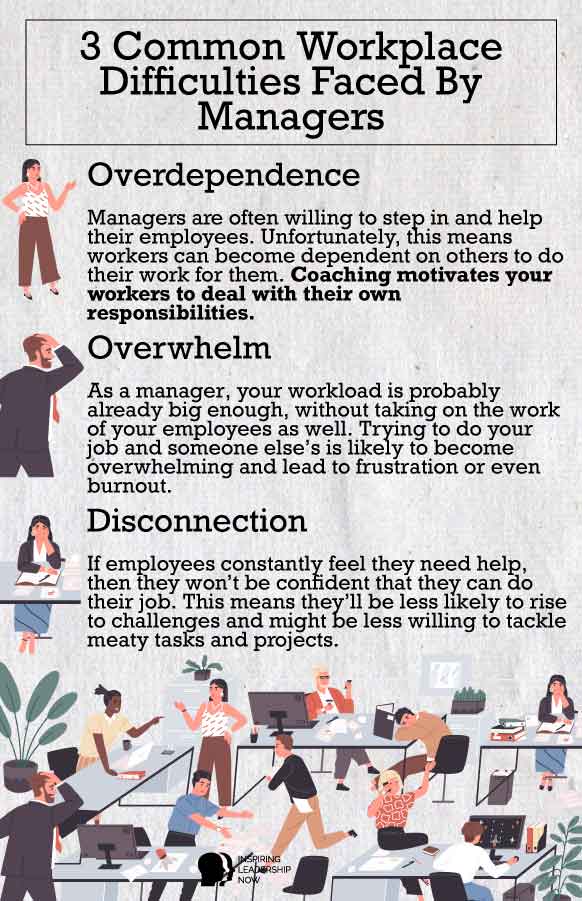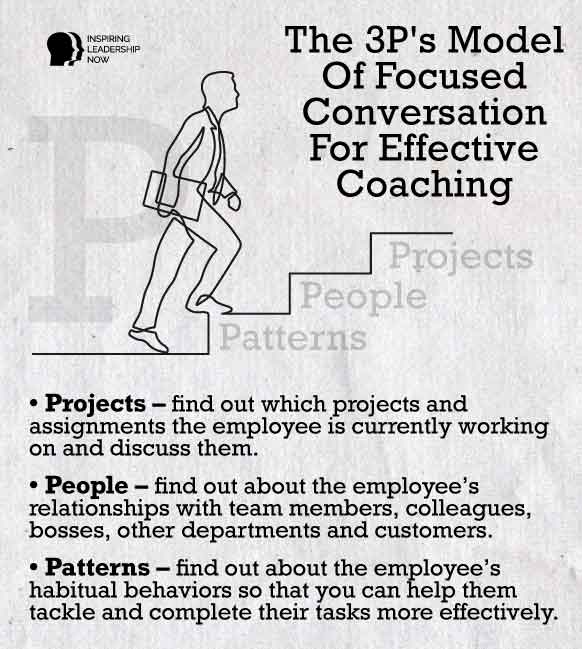Last updated: 17 July 2020

Want to discover how to coach employees so you can inspire their growth, independence and success?
First of you, we congratulate you.
Wanting to see your team grow, develop and succeed (even beyond you) is what true leadership (rather than “ego-ship”) is all about.
So we commend you.
But to get started…
You need to “say less, ask more & change the way you lead forever.”
That’s the subtitle of Michael Bungay Stanier’s book The Coaching Habit.
But why is it so important for leaders and managers to coach their team members?
Good coaching helps your employees develop their skills and master their jobs.
It makes them less dependent on managers and team leaders, who can be freed up to get on with their own tasks.
It’s an effective tool for improving relationships with colleagues, customers and family.
Yet despite the enormous potential of coaching to inspire workers and improve their performance, very few managers do it properly.
In fact, most coaching is either ineffective or counterproductive.
But before finding out what you can do about that, let’s discover more about what coaching actually is.
What Is Executive Coaching & Why Is It Used To Improve Ways On How To Coach Employees?
In an article from EnterpriseStudy.com which explains the importance of coaching in the workplace, coaching helps employees improve their existing skills and acquire new ones.
Individuals and groups have been shown to perform better as a result of good coaching practice, leading to improvements in productivity, communication and commitment, as well as a decrease in stress and tension.
At its best, coaching involves asking and providing guidance, provoking thought rather than giving directions, and holding employees accountable for their own goals. The aim is to guide and help someone work out their own course of action.
During coaching, you might occasionally offer advice as well, such as sharing personal stories or recounting your own hero’s journey to help workers arrive at their own conclusions.
Besides helping employees improve their performance, a company might use coaching for several other reasons, such as:
- When talented workers are not meeting expectations
- When new systems or working practices are introduced
- When managers and leaders need to acquire new skills and responsibilities
Coaching has become a crucial element in maintaining a healthy and thriving business. But if you’re not already practicing it correctly, what can you do about it and improve your ways on how to coach employees?
You Need To Develop A Coaching Habit
Author Stanier suggests developing what he calls a “coaching habit.”
Do that and you’ll be able to avoid these 3 common workplace difficulties that managers are often faced with:

Coaching employees is a way of helping them change their behavior so they can become more productive and more efficient workers.
According to Stanier, there are 5 elements that need to be in place so that you can develop a strong coaching habit:
- A reason – what’s the motive for changing the behavior?
- A trigger – what triggers the old behavior? You need to know what triggers the old behavior in order to stop it occurring.
- A micro-habit – ensure the new habit can be completed in less than 60 seconds.
- Effective practice – it helps to break the new habit down into small segments, and then do it over and over and over again in as many different ways as possible.
- A plan – it’s likely that the old habit will still occur once in a while. Keep your focus on the new habit by recognizing the trigger and being aware when the old habit resurfaces.
Stanier adds that to be an effective coach, you need to “change the way you have conversations with the people you manage, influence and engage with.”
And for this approach to be successful, you need to train yourself to ask 7 essential questions.
The 7 Essential Questions Of Effective Coaching
Here are the 7 questions aspiring coaches and leaders should ask to help their employees and team members reach their own solutions and come to their own conclusions– one way on how to coach employees in a non-intrusive manner.
1. The “Kick-Start” Question
To begin with, ask “What’s on your mind?” to kick-start a focused conversation.
This question puts the other person in charge of the conversation’s direction. It also makes it clear that you want to talk about your employee’s issues and not your own.
You can help to focus the conversation using the 3P model, in which the 3 P’s are:

2. The “AWE” Question
Ask, “And what else?” Stanier describes this as the single most effective coaching question. By asking this question, you remember that it’s more important to listen than it is to talk.
It also generates greater understanding and enhanced self-knowledge, making it easier for you to have a meaningful two-way conversation.
The AWE question gives the employee free rein to discuss whatever is on his or her mind. They’re not likely to tell you everything after you’ve asked the first question, so this gives them the space they need to either elaborate or pick up on another important concern.
The idea is for you as the coach to talk less and to listen more. It’s not always easy to do, which is why practice is so crucial.
3. The “Focus” Question
Ask, “What’s the real challenge here for you?” This question helps you to uncover a deeper issue.
The truth is that, when you ask what’s on their mind, you may only get a superficial response. It could be that there are numerous challenges facing them but there’s one that’s particularly important to resolve.
Asking this question helps to personalize things and also helps the employee prioritize what matters most.How to coach employees in a sympathetic and non-intrusive approach can be challenging to some managers.
Resist the temptation to jump in and try to solve the first thing they tell you. As Stanier puts it:
“the essence of coaching lies in helping others and unlocking their potential”
– and not in simply giving them advice on the first issue that crops up.
4. The “Foundation” Question
Ask, “What do you want?” This question is designed to lead you directly to the main challenge. It has a companion question as well, which is “What do you really want?”
For instance, does the employee want a bigger working space?
- Shorter hours?
- To leave early on a certain day?
- More training opportunities?
The trick is to get at the need that underlies the want.
- Why do they want shorter hours?
- Why do they want to leave early?
Knowing why will help you understand the underlying need so that you’re in a better position to address the want.
5. The “Lazy” Question
Next ask, “How can I help?” This question cuts through the hemming and hawing to get straight to the point and save time. Your employee needs to tell you what they need from you with regards to what matters most to him or her.
It’s called the “lazy” question because it’s designed to stop you from jumping in and trying to solve the problem before you fully understand the situation and what the employee really wants from you.
Another way to phrase the question is to ask, “What do you want from me?” You can make it less blunt by prefacing it with a phrase such as: “To help me understand better” or “Just to make it absolutely clear”.
6. The “Strategic” Question
Ask, “If you’re saying yes to this, what are you saying no to?” With this question you’re asking your employee to commit to the previous yes. That means that they’ll be unable to try to get out of it by telling you they “never said they were going to do” something.
In other words, if your employee is saying “yes” to whatever they need help with (from question 5), then they must be saying “no” to some current tasks or projects. That means you can use the 3P model to find out what things they’ll have to give up.
So you’ll probably need to know: which projects need to be delayed or ended; which people they need to sever ties with or make new connections with; which habits or patterns need to be broken or installed.
7. The “Learning” Question
Finally ask, “What was most useful for you?” This question helps make the coaching session meaningful for everyone concerned. It’s meant to give the employee time to pause and reflect on the important new information that came out of the conversation.
In other words, what have they learned from the session? It’s a question that coaches should ultimately ask themselves as well.
Asking these questions will help to focus the conversation so that it doesn’t wander off course, lose its momentum or end up being a pointless and unproductive exercise.
Executive Coaching Can Make People More Successful

According to a Harvard Business Review article, executive coaching is designed to help employees learn rather than teaching them, “unlocking a person’s potential to maximize their own performance”.
The folks at Forbes.com list 6 different ways that a good coach can help anyone improve, which are briefly summarized below:
1. Helping them develop a more accurate self-awareness
A good coach will provide feedback so employees know how others see them, helping them pinpoint their strengths, their weaknesses, and highlighting any areas where they might need to improve.
2. Helping them evaluate others more clearly
A good coach will help employees get an objective view of other members and their capabilities.
3. Helping them learn new ways to respond
A good coach will help team members strive to develop the skills they need to keep moving forward and to avoid stagnation.
4. Helping them leverage their existing strengths
A good coach will help employees make the most of their existing strengths, which they may be underutilizing.
5. Helping them build more productive relationships
A good coach will help team members question their relationships which are often with people like themselves, to stop them from making assumptions about colleagues so they can form stronger relationships with a wider range of people.
6. Helping them achieve what they want
A good coach will help employees clearly identify their goals and aspirations, as well as the things they need to do in order to achieve them.
An effective executive coach can help staff develop new ways of thinking and tap into the skills they need to reach their career goals.
But as Erika Andersen writes at Forbes.com, there are two caveats: the coach has to be good, and the employee has to be coachable.
As long as those two criteria are met, there’s every reason to believe that coaching, and how to coach employees effectively will bring huge benefits to all members of your organization.


